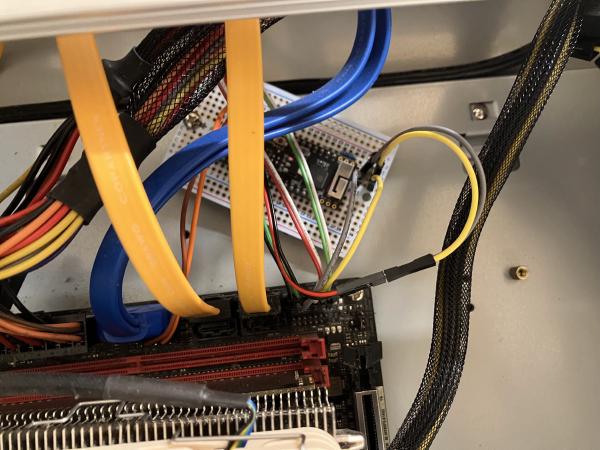I was pleasantly surprised by how easy it was to make it possible to push a PC’s power button remotely via MQTT by wiring up an ESP32 microcontroller, a MOSFET, a resistor, and a few jumper wires.
While a commercial solution like IPMI offers many more features like remote serial, or remote image mounting, this DIY solution feels really magical, and has great price performance if all you need is power management.

Motivation
To save power, I want to shut down my network storage PC when it isn’t currently needed.
For this plan to work out, my daily backup automation needs to be able to turn on the network storage PC, and power it back off when done.
Usually, I implement that via Wake On LAN (WOL). But, for this particular machine, I don’t have an ethernet network link, I only have a fiber link. Unfortunately, it seems like none of the 3 different 10 Gbit/s network cards I tested has functioning Wake On LAN, and when I asked on Twitter, none of my followers had ever seen functioning WOL on any 10 Gbit/s card. I suppose it’s not a priority for the typical target audience of these network cards, which go into always-on servers.
I didn’t want to run an extra 10 Gbit/s switch just for WOL over an ethernet connection, because switches like the MikroTik CRS305-1G-4S+IN consume at least 10W. As the network storage PC only consumes about 20W overall, I wanted a more power-efficient option.
Hardware and Wiring
The core of this DIY remote power button is a WiFi-enabled micro controller such as the ESP32. To power the micro controller, I use the 5V standby power on the mainboard’s USB 2.0 pin headers, which is also available when the PC is turned off and only the power supply (PSU) is turned on. A micro controller with an on-board 5V voltage regulator is convenient for this.
Aside from the micro controller, we also need a transistor or logic-level MOSFET to simulate a push of the power button, and a resistor to control the transistor. An opto coupler is not needed, since the ESP32 is powered from the mainboard, not from a separate power supply.
The mainboard’s front panel header contains a POWERBTN# signal (3.3V), and a
GND signal. When connecting a typical PC case power button to the header, you
don’t need to pay attention to the polarity. This is because the power button
just physically connects the two signals.
In our case, the polarity matters, because we need the 3.3V on the transistor’s
drain pin, otherwise we won’t be able to control the transistor via its base
pin. The POWERBTN# 3.3V signal is typically labeled + on the mainboard (or
in the manual), whereas GND is labeled -. If you are unsure, double-check
the voltage using a multimeter.
Bill of Materials
- WiFi-enabled microcontroller with 5V power input, e.g. the Espressif ESP32 Pico Kit
- transistor or logic-level MOSFET for working with 3.3V, e.g. 2N7000 (→digikey)
- 1K resistor for controlling the transistor, e.g. CF14JT1K00
- a bread board and/or case for mounting, e.g. Adafruit Perma-Proto.
Schematic
Software: ESPHome
I wanted a quick solution (with ideally no custom firmware development) and was already familiar with ESPHome, which turns out to very easily implement the functionality I wanted :)
In addition to a standard ESPHome configuration, I have added the following lines to make the GPIO pin available through MQTT, and make it a momentary switch instead of a toggle switch, so that it briefly presses the power button and doesn’t hold the power button:
switch:
- platform: gpio
pin: 25
id: powerbtn
name: "powerbtn"
restore_mode: ALWAYS_OFF
on_turn_on:
- delay: 500ms
- switch.turn_off: powerbtn
I have elided the full configuration for brevity, but you can click here to see it:
full ESPHome YAML configuration
esphome:
name: poweresp
esp32:
board: pico32
framework:
type: arduino
# Enable logging
logger:
mqtt:
broker: 10.0.0.54
ota:
password: ""
wifi:
ssid: "essid"
password: "secret"
# Enable fallback hotspot (captive portal) in case wifi connection fails
ap:
ssid: "Poweresp Fallback Hotspot"
password: "secret2"
captive_portal:
switch:
- platform: gpio
pin: 25
id: powerbtn
name: "powerbtn"
restore_mode: ALWAYS_OFF
on_turn_on:
- delay: 500ms
- switch.turn_off: powerbtn
For the first flash, I used:
docker run --rm \
-v "${PWD}":/config \
--device=/dev/ttyUSB0 \
-it \
esphome/esphome \
run poweresp.yaml
To update over the network after making changes (serial connection no longer needed), I used:
docker run --rm \
-v "${PWD}":/config \
-it \
esphome/esphome \
run poweresp.yaml
In case you want to learn more about the relevant ESPHome concepts, here are a few pointers:
- https://esphome.io/components/wifi.html might need to set
use_address - https://esphome.io/components/switch/index.html
- https://esphome.io/components/mqtt.html
Integration into automation
To push the power button remotely from Go, I’m using the following code:
func pushMainboardPower(mqttBroker, clientID string) error {
opts := mqtt.NewClientOptions().AddBroker(mqttBroker)
if hostname, err := os.Hostname(); err == nil {
clientID += "@" + hostname
}
opts.SetClientID(clientID)
opts.SetConnectRetry(true)
mqttClient := mqtt.NewClient(opts)
if token := mqttClient.Connect(); token.Wait() && token.Error() != nil {
return fmt.Errorf("connecting to MQTT: %v", token.Error())
}
const topic = "poweresp/switch/powerbtn/command"
const qos = 0 // at most once (no re-transmissions)
const retained = false
token := mqttClient.Publish(topic, qos, retained, string("on"))
if token.Wait() && token.Error() != nil {
return fmt.Errorf("publishing to MQTT: %v", token.Error())
}
return nil
}
Conclusion
I hope this small project write-up is useful to others in a similar situation!
If you need more features than that, check out the next step on the feature and complexity ladder: PiKVM or TinyPilot. See also this comparison by Jeff Geerling.
I run a blog since 2005, spreading knowledge and experience for almost 20 years! :)
If you want to support my work, you can buy me a coffee.
Thank you for your support! ❤️